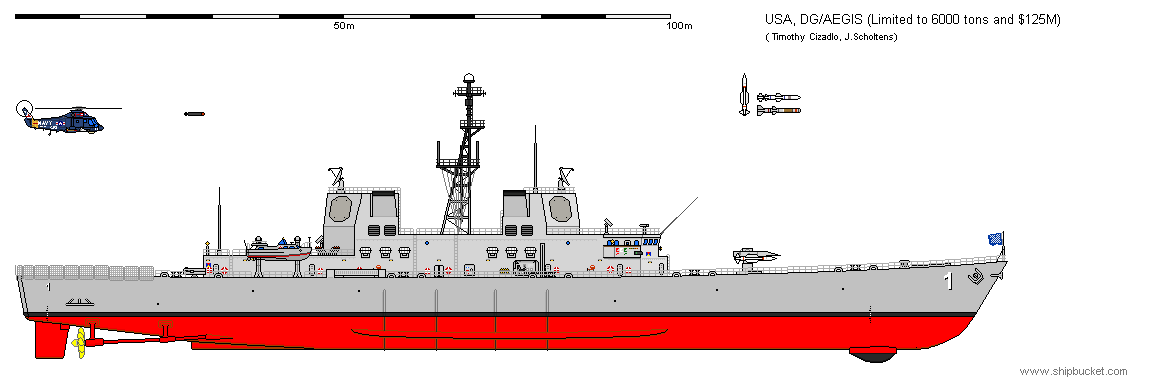Here's an edited excerpt from "Naval Surface Combatants in the 1990s: Prospects and Possibilities" By Peter T. Tarpgaard, United States. Congressional Budget Office (1981):
Open Ocean Destroyer (DDGY). This ship, which for convenience is designated DDGY, is illustrative of a warship that would result from different choices on the design trade-off issues discussed in Appendix C. It would be an offensively oriented surface combatant capable of battle group operations, but optimized more for broad ocean operations in the context of a worldwide naval war rather than for the intensive, frontal assault scenario used to derive the DDGX requirements.
The DDGY would carry the same vertical launching system and the same systems, including cruise missiles, as the DDGX. It would be significantly smaller than the DDGX, however, because of the effect of the design trade-offs discussed below and because, unlike the DDGX, it would not have space and weight capacity for unspecified future growth. 6/
In AAW, the DDGY would emphasize "back-end" technology and would use an advanced missile fire control system to achieve high firepower at shorter ranges. It would use the advanced SM-2 AAW missile and would have the long-range area AAW capability of that missile. 7/ Although this system would probably be less capable, particularly in a jamming environment, that the one proposed for the DDGX or AEGIS, it should be considerably less expensive than AEGIS and much more capable than any of the pre-AEGIS AAW systems on existing cruisers and destroyers.
In ASW, the DDGY emphasizes long-range passive detection with a towed-array sonar whereas the DDGX emphasizes active detection using the SQS-53 sonar. The DDGY would also be fitted with an active sonar, but would utilize the smaller SQS-56 rather than the larger, more expensive SQS-53 carried by the DDGX. The DDGY would carry two LAMPS III helicopters, which are essential to its long-range ASW orientation and would also provide it with an independent over-the-horizon surveillance and targeting capability.
The DDGY is assumed to have the same propulsion as the DDGX; but being a smaller ship, it would be a bit faster. It's range, however, would be about 10 percent less than that of the DDGX.
Finally, the DDGY would be fitted with a gun and a relatively simply gun fire control system suitable for surface engagements and shore bombardment. Although a gun is unlikely to be useful in a modern battle group engagement, it could still be vital for independent patrol and presence operations and for support of amphibious landings.
Emphasizing long-range towed-array ASW rather than shorter-ranged active sonar, carrying its own helicopters, and mounting a large-caliber gun for antisurface and shore bombardment missions, the DDGY would be better equipped for independent operations outside of the battle group than would the DDGX.
In addition to carrier battle group operations, the DDGY could operate with surface action groups. In this role, its aircraft would provide over-the-horizon surveillance and its towed-array sonar would provide long-range detection of submarines. The DDGY could also act in support of amphibious landings, providing AAW and ASW protection en route and gunfire support during the assault. It could also operate with frigates in escorting replenishment ships and convoys, substantially increasing the protection provided. Finally, the DDGY could operate independently in patrol and presence or ocean area control missions.
The DDGY would, however, have less capability in its air search radar than the DDGX. The DDGY's AA capabilities would nevertheless be very good in any but the highest-threat environments, and in future battle groups it would have the advantage of data-linked air target information from the DDGX and AEGIS ships.
Using the size and cost impact estimating factors presented by the Navy in discussing various destroyer trade-off issues, it is estimated that the DDGY would have a full-load displacement of about 5,000 tons and a follow-on ship cost of about $375 million (fiscal year 1982 dollars). Its size and cost rationale is outlined in Appendix D.
____________________________________________________________________________________________________________________________________________________________
6/ Provision of space and weight for future growth is a relatively recent development in U.S. design practice. In addition, U.S. designers use relatively large "margins" in their designs. Margins are allowances for unforeseen growth as design and construction progress. These practices tend to produce larger ships for a given payload than would be built in countries such as the Soviet Union or Italy where such allowances are much more austere. For a discussion of this, see J.W. Keho, C. Graham, K.S. Brower, and H.A. Meier, "NATO and Soviet Naval Design Practice, Eight Frigates Compared", International Defense Review (7/1980), pp. 1003-10.
7/ This concept assumes that high firepower is achieved through the use of the ICW and agile beam illuminator technology described in Chapter III. At long range, the multiple target engagement technique could not be used because of power limitations. Long-range engagements do not, however, normally have the time urgency of short-range engagements.



